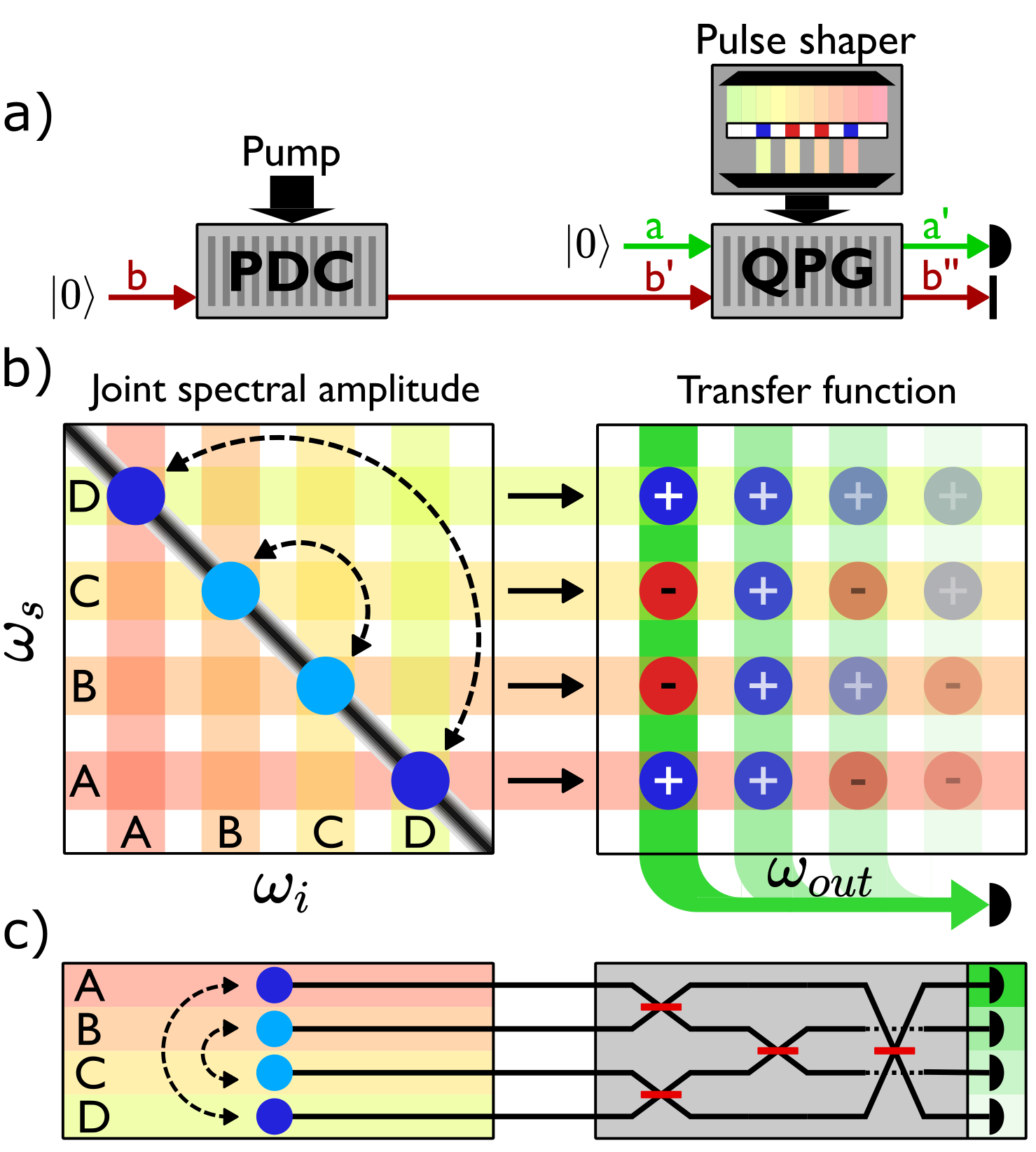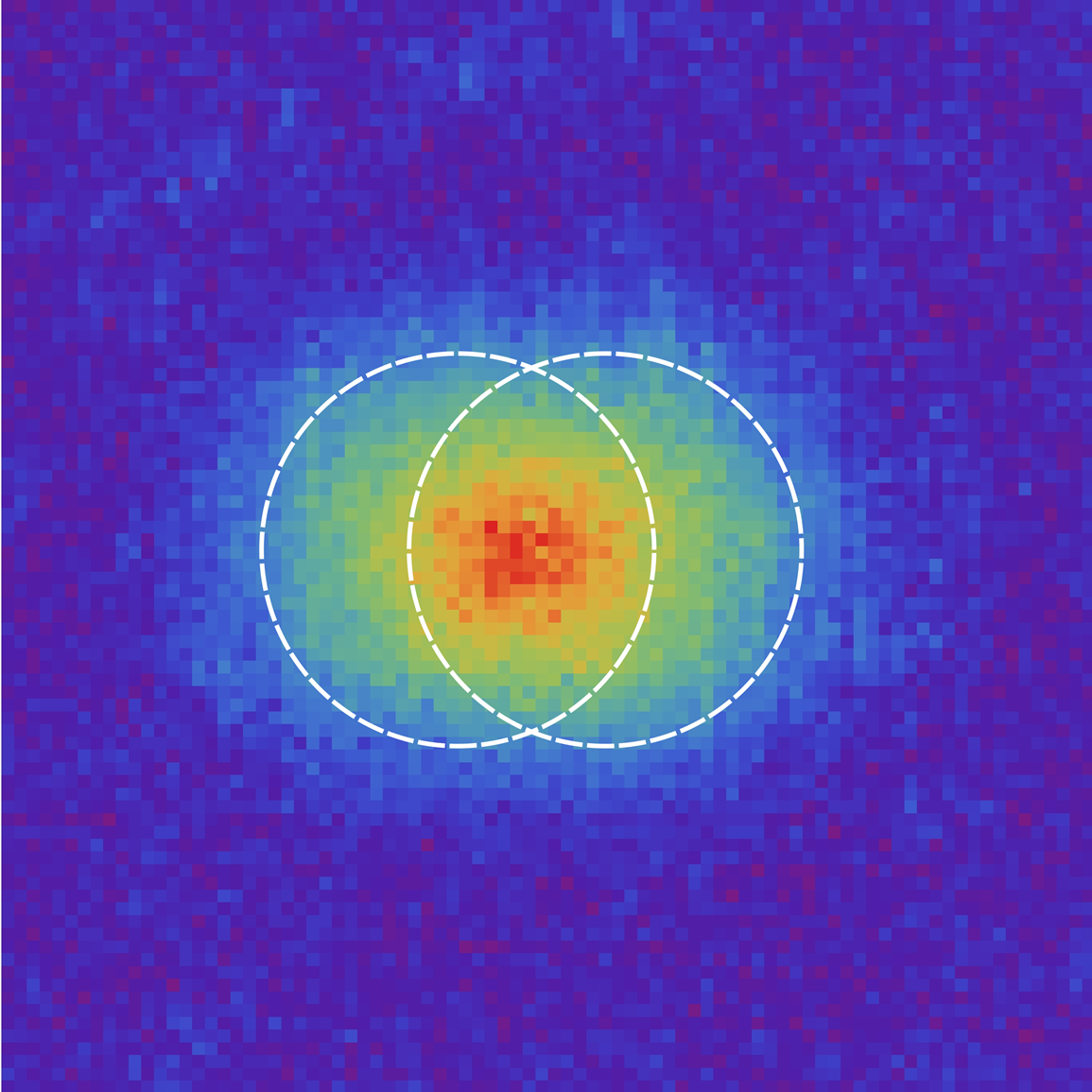Research
The integrated quantum optics group (IQO) at Paderborn university (UPB) has a long history in working with quantum pulse gates (QPGs), which are specially designed and in-house fabricated non-linear optical devices, allowing for temporal mode selective frequency conversion. In this research project UPB is primarily concerned with using the versatile capabilities of the QPG to experimentally implement different quantum measurement schemes. In particular, it is possible to measure the temporal separation of two incoherent ultrashort light pulses, with a resolution reaching the ultimate quantum limit. Furthermore, the role of optical coherence on the temporal resolution in these experiments was investigated. The QPG was also used to implement a quantum state reconstruction of light in the telecommunication band at the single-photon level, by employing a randomized compressive tomography scheme.
The current work of UPB focusses on exploring the use of quantum states, generated by parametric down conversion sources (PDC), as input for the QPG. This enables interesting new research directions by exploiting the quantum properties, for instance squeezing, of the PDC light. The PDC states are compelling quantum resources because they can be multimode and strongly correlated. The use of QPGs then allows one to generate arbitrary superpositions of these modes. To achieve this, the devices must be properly engineered, which then paves the way towards a completely new type of system design that combines the benefits of state of the art quantum light sources and quantum measurements to enable novel applications in quantum metrology and networking.
The Ultrafast Quantum Optics Group at Imperial College London focuses on quantum optics and its applications in quantum networking, quantum computing and simulation. We have two parallel research streams within the Stormytune project. Firstly, we are investigating the temporal-mode properties of optical quantum memories, and how these devices can be used as a coherent temporal mode filter for single-photon sources. We are developing quantum memories in warm alkali vapour that store optical signals via two-photon emission/absorption processes in atomic ensembles, and we are demonstrating that these devices can be optimised to store just one user-defined temporal mode. We will then tailor the mode of these devices to store the dominant mode of an imperfect single-photon source, and therefore coherently filter the single-photon source and improve its indistinguishability properties. The second research stream focuses on multi-parameter estimation in the time-frequency domain. This will be enabled by high-gain squeezers together with photon-number measurements with transition-edge sensors (TES) to engineer tailored probe states. Furthermore, weak-field homodyne with TES will allow multiparameter estimation to be performed which is applicable to studying dynamical processes.
The multimode quantum optics group of the Laboratoire Kastler Brossel at Sorbonne Université (SU) is a pioneer in the research of quantum properties of multimode light. Historically, they have exploited the spatial mode structure of light for estimating parameters beyond the shot noise limit. In the past decade, they also made important breakthroughs in the study of quantum features enshrined in time-frequency modes. To do so, the group relies on a synchronously pumped optical parametric oscillator to generate a quantum frequency comb. The light it can produce comprises many different frequencies, which are all quantum entangled to each other. The quantum properties of this light can be unveiled by an optical technique known as homodyne measurement which makes it possible to measure the values of the electric field.
In Stormytune, SU will develop multipixel homodyne detectors to probe the electric field at different frequencies simultaneously. Their ultimate goal is to use this new technique to estimate parameters that are encoded in time-frequency degrees of freedom of the light, and do so with unprecedented precision. Furthermore, the theoreticians of SU will develop methods to perform such parameter estimation as precise as possible while taking into account all experimental imperfections. This can then be compared to ultimate quantum limits, the notorious quantum Cramér-Rao bound, that characterise the best precision one could possibly hope to achieve.
UNIRM3 New Quantum Optics Group (NEQO) has a strong expertise in experimental quantum and ultrafast metrology. Our current research is now focused on merging these two aspects, leveraging on STORMYTUNE to explore quantum metrological problems in the frequency domain.
In the last years, we have extensively worked on multi parameter metrology and its application to delicate systems. In this regard, our contribution to the STORMYTUNE project will be centred on investigating, from a metrological perspective, the effects of the interaction of an absorptive material with quantum light. When light passes through an absorptive system it undergoes frequency-dependent losses. These are linked, through Kramers Kronig relations, to the refractive index of the system, which imparts a spectrally-dependent phase on the transmitted light. As our first task, we aim at establishing the role of Kramers Kronig relations in estimating the spectral phase, exploring if and how these can improve the estimation process.
Characterizing frequency states and processes requires access to both the spectral amplitude and phase. For our second task we will seek efficient strategies for these characterizations. We will focus on the use of Stimulated Emission Tomography, allowing for the characterisation of the same nonlinear optical processes generating single photon states, while using seeding that guarantees high enough intensities. We will focus on how to optimise the characterization by employing compressed sensing techniques developed by other partners in order to minimise the number of resources required.
CNR Quantum Nanophotonics group (NEQO) has a strong expertise in nano-quantum optics. In particular our research focuses on the development of molecular quantum emitters for quantum photonic simulations, computing and metrology. We also benefit from the integration of single emitters to photonic structures in order to optimize control and collection efficiency. Thanks to STORMYTUNE we will develop unconventional pumping schemes that will drive quantum emitters into the field of TF modes, accessing the single photon regime.
In the last years, we have been focusing on one peculiar aspect that is the measurements of two photon interference using distinct single photon sources. This paradigmatic metrology experiment, based on an exquisitely non-classical phenomenon, allows determining certain relative spectral properties of the sources, and is at the basis of most photonic quantum technologies today. Within STORMYTUNE we plan to extend this study also to shaped single-photon pulses.
The group of Universidad Complutense de Madrid (UCM) has been involved in exploring the ultimate resolution in timing measurements. We have been collaborating in the theory of multiparameter estimation that has been implemented in the consortium.
We have also explored the role that partial coherence plays in the fundamental resolution. We have contributed to a solid theory that has been tested in the laboratory and clarifies the recent debate on the effects of partial coherence.
We have also developed an adaptive compressed-sensing tomography that works in the spatial and the time-frequency domain and that allows us to uniquely determine unknown signal states using very few measurement configurations. This is especially relevant in the single-photon regime, where a small number of copies of a state and practical limitations on measurement times require the efficient use of resources. The protocol has been implemented by the consortium, showing the considerable advantage of the method.
The research of UPOL team from Palacky University, Olomouc is oriented to quantum tomography, detection and estimation problems. It consists of 2 professors, 2 post-docs and 4 PhD students. Profs. Z. Hradil and J. Rehacek have substantially contributed to statistically motivated estimation methods such as MaxLik and MaxEnt estimation, quantum state reconstruction and recently to the super-resolution achieving the limit of Quantum Fisher information.
UPOL group will participate in all the work-packages leading the WP3 Time-Frequency super-resolution imaging. The team members are involved in proposing and analysing of the protocols for quantum super-resolution, quantum multi-parameter estimation, quantum tomography and compressed sensing. The team has long term experience with analogous problems in spatial domain adopting statistical methods for protocols inspired by quantum information processing and experimental techniques of digital holography and image processing. Recently, they have addressed the problem of Rayleigh criterion, which specifies the minimum separation between two incoherent point sources that may be resolved into distinct objects. Based on Quantum Fisher Information and the resulting Cramér–Rao bound, spatial, temporal or spectral separations between incoherent mixtures o can be resolved with a tenfold improvement in precision over the intensity-only Crame ́r-Rao bound. The research of the team within the project will focus mainly on the theoretical aspects of the protocols for optimal detetction and will help to analyse and interpretate experimental data.
In Stormytune we are interested in practical limitations imposed by experimental conditions, such as finite bandwidth of the signal. We develop methods helping us asses the influence of these limitations to superresolution in time and frequency domain. In our theory-oriented research we work in close collaboration with UCM and UPOL.


